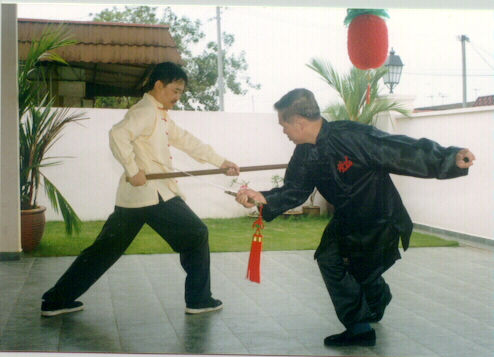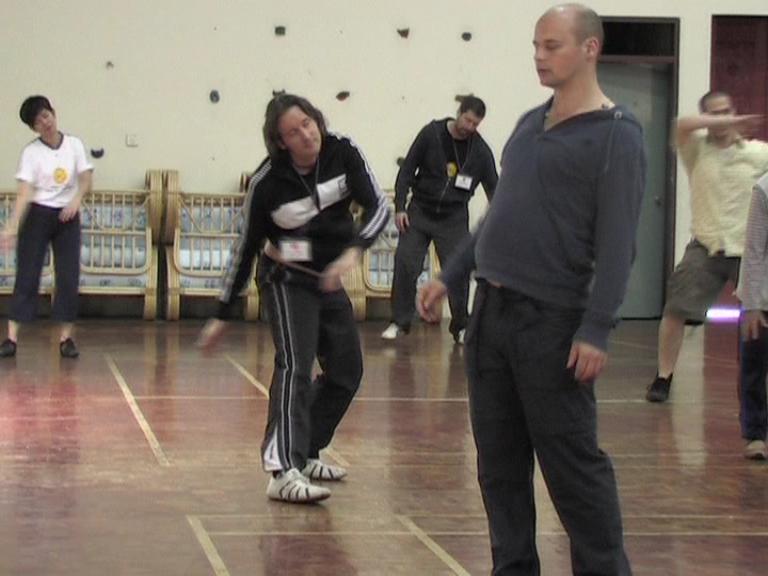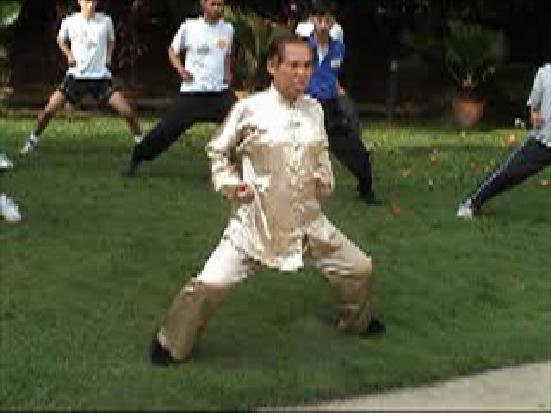SELECTION OF QUESTIONS AND ANSWERS
FEBRUARY 2011 PART 3

A crucial reason to practice any martial art is not to be hit at all. At the 2010 Shaolin Wahnam International Free Sparring Competition, although it was full contact free sparring, not a single competitor was hurt!
Question 1
I was practicing karate until I was injured by a black belt. I never asked why, I just left.
— James, Australia
Answer
Frankly I am shocked at the amount of injuries students, and even masters, sustain in their martial art training. I am more shocked that these injuries are routinely left unattended to.
It is obvious that internal injuries not only affect a person's health and vitality but also his longevity. In other words, due to his internal injuries sustained in his martial art training, he will be less healthy, have less vitality and would not live as long as he should had he not trained the art.
Most martial artists do not depend on their martial arts for livelihood. They also usually do not need to fight. It just does not make sense why they willingly subject themselves to such punishment by practicing their martial art as a hobby.
Indeed, if they are ready to put aside personal pride and prejudices, and pause to reflect objectively, they should realize that what they practice can't be a genuine martial art. No martial art can afford to subject its practitioners to be routinely punched and kicked during training. In fact a principal aim of practicing any martial art is not to be hit at all.
Question 2
The injury was to a floating rib -- a lump. I was practicing chi kung from a book and I have been applying meditation to the lump and it had been very helpful until 2 weeks ago when I was running I heard a pop sound and then pain in the same spot came later.
Answer
If you sustain internal injury and your instructor cannot help you, you should consult a good kungfu or chi kung master or a good Chinese herbalist. In areas of internal injuries, conventional Western doctors would not be as effective. (They may be more effective in other areas of injury and sickness.)
You should not try to heal yourself by reading a book, no matter how good that book may be. The quality and length of your life are at stake.

In practicing any martial art, injuries are the exception, not the rule, even in weapon training
Question 3
After reading the "Art of Shaolin Kung Fu" which I practiced (first form), I went to a Chinese herbalist. The counter-person didn't know a few ingredients (chi yao, hu gu) and there was one ingredient, ji geng, which maybe missed a letter. She did show me "jig geng" which was on her stock list. I truly hope you can help me.
Answer
"Chi yao", "hu gu" and "ji geng" are common ingredients of medication for overcoming internal injuries. If she doesn't know these ingredients, you should seek the help of another herbalist, or a kungfu or a chi kung master. You should not have much difficulty finding some good ones in Brisbane if you make an effort.
Question 4
Thank you because your books have been life changing and one day we will meet.
Answer
If you wish to meet me one day, I would like to see a young healthy man, not an old man in his 20s or 30s loaded down with internal injuries.
It is also helpful to note that if my books have changed your life, the change should bring practical benefits, not merely intellectual knowledge.

Chi flow is an excellent mean to overcome internal injuries
Question 5
Letting go is the consciousness (awareness meditation) itself. It results from strong mindfulness. When someone lets go, he has already acknowledged the thoughts, distanced from them and therefore can let go of all thinking. He can also be aware of how well he can let go. This is the pure consciousness. Am I correct?
— Denas, Lithuania
Answer
These are just words. Depending on how we use words, we can prove you correct or wrong.
For fun, let me use words to prove you wrong.
Letting go is not the consciousness or awareness meditation. A person may let go, like when he faints, and lose his consciousness and awareness.
Letting go is not the result of strong mindfulness. Rather, it is a pre-requisite for mindfulness. But letting go itself may not necessarily bring about mindfulness.
When someone lets go, it is not necessary that he has already acknowledged his thoughts, and has distanced himself from his thoughts. He may not have any thoughts to start with before he lets go. On the other hand, after he has let go, he may still think, if he wants to.
He may or may not be aware of how well or badly he can let go. Mentally handicapped persons can let go easily, but they may be unaware of what they are doing.
Letting go is not pure consciousness. When they have successfully let go, others can still clearly see their physical form.
On the other hand, I may also use words to prove that you are correct.
If I can prove you right or prove you wrong depending on how I use words, does it mean I twist facts to fit my words? Does it mean I intend to confuse you? No, it is the reverse. The facts remain the same. It is how words are used that highlights certain facts. My intention is not to confuse you, but to enable you to see facts more clearly. Indeed, many conflicts, ranging from personal to international, can be avoided if people realize that the same facts can, and often are, interpreted or intellectualized differently.
An analogy may make this clearer. Let us take the statement "All men are equal". The facts are the same, but depending on how we intellectualize and interpret words, we can prove this statement right or wrong.
If we interpret "men" as individuals, different people are not equal. Some are tall, others short, some live in lands of plentiful, others endure hunger and poverty. But if we interpret "men" as people in general, they are equal as all of them are subjected to the same natural laws, like all are born as babies, become adults, grow old and eventually die.
What is the moral of this answer? We should not be a slave to intellectualization.
Question 6
I perform the physical exercise, "Single Leg Squats", one hundred repetitions with one leg. I found that this exercise in Chinese is called "Red Child Worships Bodhidattva Guan Yin". Could you tell more about this exercise (chi kung aspect)? I believe that one must be totally relaxed while performing this exercise.
Answer
This is a good exercise, especially for agility. My sifu, Sifu Chee Kim Thong, regarded by some as a treasure of China, used to perform this exercise frequently.
"Red Child Worships Bodhisattva Guan Yiun" can be performed as physical exercise or as chi kung. The form is the same. The main difference is that as a physical exercise, practitioners work on their physical body, like loosening joints and musces. But as chi kung, they work on energy, which will give them good health, vitality and longevity.
Performing it as physical exercise will not get them these chi kung benefits. This is the same as all other chi kung patterns practiced as physical exercises by most people.
Why is it so? It is because of energy flow. By practicing it or any pattern as chi kung, practititioners generate an energy flow, whereas practicing it as physical exercise does not.
When the energy flow breaks through blockages, practitioners recover from illness. When the energy flow is smooth, they have good health. When the energy flow becomes vigorous, they have vitality. When they have generated a lot of energy, the stored up energy enables their energy flow to go on for a long time, giving them longevity.
Performing the technique a hundred times is too long. You should aim at quality. Performing for about 30 times is sufficient to produce a good energy flow.

It is very important to practice stance training correctly. Correct practice will bring many benefits, but wrong practice will bring harmful effects.
Question 7
To perform everything better (cycling, swimming, running etc) I do like this: Be totally relaxed, focus on the energy and let go of all thoughts. Can I do this or have you any advice? Is it not harmful? I do it gently.
Answer
This is good. It is not harmful if you do it gently.
It is much better if you can direct your chi to do whatever work for you. If you do it correctly, you won't be tired or panting for breath. Of course you have to learn this invaluable skill form a master.
You can see students at my review courses in Penang using chi to perform their daily tasks by clicking here.
Question 8
Sifu Wong, I am sorry if you find these questions stupid, but please correct me if you find so.
If I go to your Intensive Chi Kung course, could I ask you to correct my horse stance for an additional price?
Answer
Not only are your questions not stupid, they are in fact very rewarding. Thank you for asking them.
I shall post them and my answers in my Question-Answer Series and I am sure many people, including Shaolin Wahnam students and instructors, will benefit from them.
I shall be delighted to correct your horse stance when you attend my Intensive Chi Kung Course. You don't have to pay any additional fee. You can also ask me check any other practices, with my compliments.
I may sound like advertising my Intensive Chi Kung Course, but I would like to tell you and other deserving students that this course is a rare opportunity one should not miss. You will be amazed at what you can learn at the three-day course.
Among many other benefits at the course itself -- not a few months after you have practiced what you learn -- you will be able to run round the size of a football field without being tired and without panting for breaths. You will be taught how to transfer this skill to your daily activities like playing games or doing any physical work.
At the course itself you will also use your newly attained mental clarity to solve problems more efficiently and without feeling mental stress. I honestly believe that just these accomplishments alone are worth many times the time and money you spend on the course.
Editorial Note: Denas' other questions can be found here, and here.
LINKS
Selected Reading
- Wahnam Taijiquan against Other Martial Arts
- Glimpses of Asking Bridge
- The Eighteen-Lohan Art
- From You Wei to Wu Wei, from Control to Spontaneity
- Examples of Intellectual Questions
